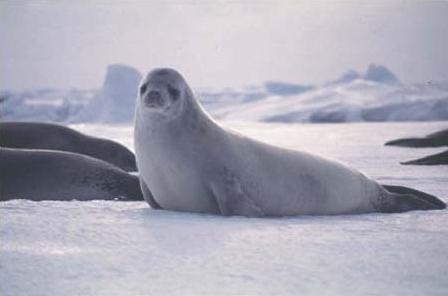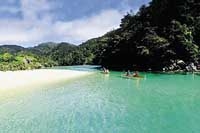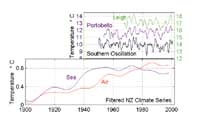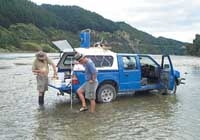PDF of this article (651 KB)

Basil Stanton
Long-term records of sea-surface temperatures around New Zealand show an overall warming over the last 100 years but there has been a slight cooling trend in the past decade.

We enjoy our ocean environment. But is it getting warmer? (Photo courtesy Fiji Travel)
The temperature of the ocean is an important part of the climate system because of the enormous capacity of the ocean to store heat and move heat around the globe.
The top 3 m of the ocean has the same heat capacity as the whole of the earth’s atmosphere. In other words, it takes the same amount of heat energy to increase the temperature by 1°C in the upper 3 m of ocean or in the whole atmosphere. Since the average depth of the ocean is 4 km, it is clear that the heat storage capacity of the ocean is immense. Consequently, temperature changes in the ocean are generally much slower than in the atmosphere. An illustration of this is that air temperatures vary markedly throughout the day, but the corresponding variations in the sea-surface temperatures are very small. Thus, the ocean acts to even out atmospheric temperature changes. However, on seasonal and longer time scales, heat exchange ensures that sea and air temperatures near the ocean surface track one another quite closely.
Global-averaged surface temperature (combined land–air temperatures and sea-surface temperatures) has increased by around 0.6°C since the late 19th Century. The records show periods of warming and cooling with distinctly different regional patterns. Between 1976 and 2000, the greatest warming was over the continents of the Northern Hemisphere. In the Southern Hemisphere there were quite large regional differences, involving both warming and cooling. What, then, has been happening to the temperature in the seas around New Zealand?
Temperature of New Zealand seas

New Zealand sea and air temperature records. (Data courtesy of Otago University, Auckland University and Dr J. Salinger, NIWA)
The two longest records of coastal sea-surface temperature (SST) in New Zealand are those from the university marine stations at Portobello, in Otago Harbour (since 1953), and Leigh, north of Auckland (since 1967). Daily temperature values have been used to calculate a running annual mean, which eliminates seasonal and other shorter-period variations (see graph left, top panel).
Even though these sites are at opposite ends of the country, we can see that the year-to-year (interannual) variations are similar. Interannual SST variations can be as large as 1.5°C, and these tend to mask any underlying trend of global warming. In fact, it can be shown mathematically that these records are too short and have too much interannual variation for any underlying warming or cooling trend to be determined.
The large interannual SST variations in New Zealand are related to El Niño–Southern Oscillation (ENSO) events: sea-surface temperatures are lower in El Niño years. The top panel (below left) shows Portobello and Leigh temperatures along with the Southern Oscillation Index: low values of the Index indicate El Niño events. Note the cooling during the 1982–83 El Niño, and the prolonged El Niño conditions in the early 1990s. Interestingly, there was not much cooling of SST during the very strong 1997–98 El Niño, illustrating that we still don't fully understand the connection between ENSO and sea temperatures.
A long-term record
Teachers: this article can be used for Physical World A.O 3 L7. See other curriculum connections at www.niwa.co.nz/pubs/wa/resources/
So how can we examine climate-related SST changes in New Zealand? The answer is to use the long archive temperature observations made during sea voyages. Beginning in the 19th Century, ships of many nations began to make routine measurements of SST. This was done by collecting a bucket of surface water and then measuring its temperature using a thermometer. In motor vessels, the engine cooling water intake has been used for SST measurements, while nowadays measurements have also become available from ocean buoys and satellite infrared measurements. A huge international effort has gone into assembling and checking these data to form a global database of SST observations. Climate scientists have combined all these different measurements into consistent data sets by applying corrections for the different measurement methods. The long-term SST records are then smoothed to reveal the underlying climate-related trend.
The lower panel in the figure (far left) compares this smoothed SST record for the ocean surrounding New Zealand with the land air-temperature record over the last century. The graph shows that SST has risen by about 0.6°C over the last 100 years, but cooled slightly over the past 10–20 years – probably caused by more and stronger El Niño events than previously. In contrast, land air temperatures have continued to increase.
So the sea around New Zealand doesn't appear to be warming at present, although there was a definite warming earlier in the 20th Century.
Will the current trend of cooling continue, or is this only a temporary pause in a global warming trend? Whatever the answer, because of the importance of ocean temperatures and heat storage in the global climate system, future international research is focusing on improved monitoring and understanding of ocean climate.
New ways of observing ocean climate: the Argo programme

Launching the first NIWA Argo drifter from NIWA's research vessel Tangaroa in September 2001.
Recent studies of subsurface ocean data show that the global ocean heat content has increased significantly since the late 1950s, and there have also been some changes in salinity. Unfortunately, there are insufficient data in the New Zealand region to determine whether such changes have occurred here. However, new technology will provide the required global coverage of subsurface data needed to understand and forecast ocean climate. This will mainly be achieved through the Argo programme (named after the Argonauts in Greek mythology).
To fully evaluate ocean climate, we require measurements of temperature and salinity at depth, not just at the surface. And we need enough samples from all over the globe to give a true picture. Nowadays, ocean scientists use high-precision profiling instruments which electronically measure temperature, salinity and water depth. It has been said that the total number of these and other measurements made in the ocean since the 1870s is less than the number of tempera-ture profiles collected in the atmosphere in a week. So there is a large mismatch between our knowledge of the ocean and the atmosphere.
Several major international experiments have aimed to make up for this knowledge gap. The latest, Argo, promises to achieve a global observing network comparable with the atmospheric monitoring programmes. This combines the use of ocean-drifting instruments and measurements of sea-surface height from satellites to give a near-complete picture of the ocean circulation along with the temperature and salinity structure. The Argo drifters sink to around 2,000 m and drift for 10 days. They then rise to the surface, measuring a profile of temperature and salinity. On the surface they transmit these data plus their position to satellite, before sinking to repeat the cycle. It is planned to seed the ocean with 3,000 Argo drifters, at spacing of about 300 km by 300 km, over the next 4 years. There are 12 countries providing floats to this programme. New Zealand is participating through NIWA: the first two New Zealand drifters were deployed from Tangaroa in September 2001.
Basil Stanton is based at NIWA in Wellington.
